Numerical Investigation of Tip Leakage Vortex Cavitating Flow in a Waterjet Pump with Emphasis on Flow Characteristics and Energy Features
Abstract
1. Introduction
2. Numerical Method
2.1. Governing Equations
2.2. Cavitation Model
3. Physical Model, Numerical Setup, and Mesh Information
4. Results and Discussions
4.1. Performance Analysis and Grid-Independence Test
4.2. Vortex Characteristics in the Tip Clearance
4.2.1. Vortex Distribution and Formation Mechanism
4.2.2. Vortex Evolution
4.3. Influence of the Cavitation on the Vortex Evolution
4.4. Entropy-Production Features in the Tip Clearance
5. Conclusions
- (1)
- The predicted hydrodynamic performance and cavitation patterns in the waterjet pump agree well with previous experimental data. The vortex structures could be accurately captured by DDES. Therefore, the model and the selected grid and numerical calculation method are suitable for capturing the transient cavitating flow.
- (2)
- The vortex characteristics in the tip clearance were investigated based on the flow distribution, formation mechanism, and evolution of the vortices. The results show that the vortex evolution in the waterjet pump was similar to that around a hydrofoil [30] and can be divided into three stages, but the vorticity variations in the waterjet pump were more complicated.
- (3)
- The relative-vorticity-transport equation was applied to discover the reason for the differences between the TLV vorticity variation observed in the waterjet pump and that observed around a hydrofoil [30]. The results indicate that the drastic fusion process of TSV cavity and the TLV cavity in the waterjet pump resulted in the formation of a triangular cavitation region near the blade tip, which is difficult to reproduce by stationary hydrofoil simulation. This fusion process caused the local variation of fluid volume and further affected the vorticity transport, which is probably the main reason for differences in the TLV vorticity variation inside the waterjet pump and around hydrofoils [30].
- (4)
- The entropy-production evaluation method considering the phase transition was then used to analyze the dissipation losses in the complex cavitation region. The results indicate that the drastic fusion process of the TSV cavity and the TLV cavity in the waterjet pump significantly influenced the entropy-production-rate distributions and enhanced the disturbance of the flow field. In addition, severe phase transition occurred in the drastic fusion region accompanied by huge phase-transition losses.
Author Contributions
Funding
Institutional Review Board Statement
Informed Consent Statement
Data Availability Statement
Acknowledgments
Conflicts of Interest
References
- Miorini, R.L.; Wu, H.; Katz, J. The internal structure of the tip leakage vortex within the rotor of an axial Waterjet pump. Turbomach 2012, 134, 031018. [Google Scholar] [CrossRef]
- Wu, H.; Miorini, R.L.; Katz, J. Measurements of the tip leakage vortex structures and turbulence in the Meridional plane of an axial water-jet pump. Exp. Fluids 2011, 50, 989–1003. [Google Scholar] [CrossRef]
- Wu, H.; Miorini, R.L.; Tan, D.; Katz, J. Turbulence within the tip-leakage vortex of an axial waterjet pump. AIAA J. 2012, 50, 2574–2587. [Google Scholar] [CrossRef]
- You, D.; Wang, M.; Moin, P.; Mittal, R. Large-eddy simulation analysis of mechanisms for viscous losses in a turbomachinery tip-clearance flow. J. Fluid Mech. 2007, 586, 177–204. [Google Scholar] [CrossRef]
- Doligalski, T.L.; Smith, C.R.; Walker, J.D.A. Vortex interactions with walls. Annu. Rev. Fluid Mech. 1994, 26, 573–616. [Google Scholar] [CrossRef]
- Denton, J.D. Loss Mechanisms in Turbomachines; American Society of Mechanical Engineers: New York, NY, USA, 1993; p. V002T014A001. [Google Scholar]
- Li, Y.S. Mixing in axial flow compressors: Part I—Test facilities and measurements in a four-stage compressor. J. Turbomach. 1991, 113, 161–165. [Google Scholar] [CrossRef]
- Mailach, R.; Lehmann, I.; Vogeler, K. Rotating instabilities in an axial compressor originating from the fluctuating blade tip vortex. J. Turbomach. 2001, 123, 453–460. [Google Scholar] [CrossRef]
- Farrell, K.J.; Billet, M.L. A correlation of leakage vortex cavitation in axial-flow pumps. J. Fluids Eng. 1994, 116, 551–557. [Google Scholar] [CrossRef]
- Kolera, C.M. The Effects of Free Stream Turbulence on the Flow Field through a Compressor Cascade. Ph.D. Thesis, Virginia Polytechnic Institute and State University, Blacksburg, VA, USA, 2002. [Google Scholar]
- Muthanna, C. Wake of a compressor cascade with tip gap, part 1: Mean flow and turbulence structure. AIAA J. 2004, 42, 2320–2331. [Google Scholar] [CrossRef]
- Wang, Y. Wake of a compressor cascade with tip gap, part 2: Effects of endwall motion. AIAA J. 2004, 42, 2332–2340. [Google Scholar] [CrossRef]
- Wenger, C.W.; Devenport, W.J.; Wittmer, K.S.; Muthanna, C. Wake of a compressor cascade with tip gap, part 3: Two point statistics. AIAA J. 2004, 42, 2341–2346. [Google Scholar] [CrossRef]
- You, D. Study of Tip Clearance Flow in a Turbomachinery Cascade Using Large Eddy Simulation; Stanford University Press: Stanford, CA, USA, 2004. [Google Scholar]
- You, D.; Mittal, R.; Wang, M.; Moin, P. Computational methodology for large-eddy simulation of tip-clearance flows. AIAA J. 2004, 42, 271–279. [Google Scholar] [CrossRef]
- You, D.; Mittal, R.; Wang, M.; Moin, P. Analysis of stability and accuracy of finite-difference schemes on a skewed mesh. J. Comput. Phys. 2006, 213, 184–204. [Google Scholar] [CrossRef]
- Zhao, Y.; Jiang, Y.; Cao, X. Study on tip leakage vortex cavitating flows using a visualization method. Mod. Phys. Lett. B 2018, 32, 1850003. [Google Scholar] [CrossRef]
- Decaix, J.; Dreyer, M.; Balarac, G. RANS computations of a confined cavitating tip-leakage vortex. Eur. J. Mech. B/Fluids 2018, 67, 198–210. [Google Scholar] [CrossRef]
- Cheng, H.Y.; Ji, B.; Long, X.P. A review of cavitation in tip-leakage flow and its control. J. Hydrodyn. 2021, 33, 226–242. [Google Scholar] [CrossRef]
- Aeschlimann, V.; Beaulieu, S.; Houde, S. Inter-blade flow analysis of a propeller turbine runner using stereoscopic PIV. Eur. J. Mech. B/Fluids 2013, 42, 121–128. [Google Scholar] [CrossRef]
- Lemay, S.; Aeschlimann, V.; Fraser, R. Velocity field investigation inside a bulb turbine runner using endoscopic PIV measurements. Exp. Fluids 2015, 56, 120. [Google Scholar] [CrossRef]
- Dreyer, M.; Decaix, J.; Münch-Alligné, C.; Farhat, M. Mind the gap: A new insight into the tip leakage vortex using stereo-PIV. Exp. Fluids 2014, 55, 1849. [Google Scholar] [CrossRef]
- Zhang, D.; Shi, W.; Van Esch, B.B. Numerical and experimental investigation of tip leakage vortex trajectory and dynamics in an axial flow pump. Comput. Fluids 2015, 112, 61–71. [Google Scholar] [CrossRef]
- Shi, L.; Zhang, D.; Zhao, R. Effect of blade tip geometry on tip leakage vortex dynamics and cavitation pattern in axial-flow pump. Sci. China Technol. Sci. 2017, 60, 1480–1493. [Google Scholar] [CrossRef]
- Huang, R.; Ji, B.; Luo, X. Numerical investigation of cavitation-vortex interaction in a mixed-flow waterjet pump. J. Mech. Sci. Technol. 2015, 29, 3707–3716. [Google Scholar] [CrossRef]
- Han, C.; Long, Y.; Xu, M. Verification and Validation of Large Eddy Simulation for Tip Clearance Vortex Cavitating Flow in a Waterjet Pump. Energies 2021, 14, 7635. [Google Scholar] [CrossRef]
- Zhang, H.; Wang, J.; Zhang, D. Numerical Analysis of the Effect of Cavitation on the Tip Leakage Vortex in an Axial-Flow Pump. J. Mar. Sci. Eng. 2021, 9, 775. [Google Scholar] [CrossRef]
- Gritskevich, M.S.; Garbaruk, A.V.; Schütze, J. Development of DDES and IDDES formulations for the k-ω shear stress transport model. Flow Turbul. Combust. 2012, 88, 431–449. [Google Scholar] [CrossRef]
- Zwart, P.J.; Gerber, A.G.; Belamri, T. A two-phase flow model for predicting cavitation dynamics. In Proceedings of the Fifth International Conference on Multiphase Flow, Yokohama, Japan, 30 May–3 June 2004. [Google Scholar]
- Cheng, H.Y.; Bai, X.R.; Long, X.P.; Ji, B.; Peng, X.X.; Farhat, M. Long. Large eddy simulation of the tip-leakage cavitating flow with an insight on how cavitation influences vorticity and turbulence. Appl. Math. Model. 2020, 77, 788–809. [Google Scholar] [CrossRef]
- Spalart, P.R.; Deck, S.; Shur, M.L. A new version of detached-eddy simulation, resistant to ambiguous grid densities. Theor. Comput. Fluid Dyn. 2006, 20, 181–195. [Google Scholar] [CrossRef]
- Strelets, M. Detached eddy simulation of massively separated flows. In Proceedings of the 39th Aerospace Sciences Meeting and Exhibit, Reno, NV, USA, 8–11 January 2001. [Google Scholar]
- Han, C.Z.; Xu, S.; Cheng, H.Y. LES method of the tip clearance vortex cavitation in a propelling pump with special emphasis on the cavitation-vortex interaction. J. Hydrodyn. 2020, 32, 1212–1216. [Google Scholar] [CrossRef]
- Jeong, J. On the identification of a vortex. J. Fluid Mech. 1995, 285, 69–94. [Google Scholar] [CrossRef]
- Leweke, T.; Le Dizes, S.; Williamson, C.H. Dynamics and instabilities of vortex pairs. Annu. Rev. Fluid Mech. 2016, 48, 507–541. [Google Scholar] [CrossRef]
- Long, Y.; Han, C.; Ji, B. Verification and validation of large eddy simulations of turbulent cavitating flow around two marine propellers with emphasis on the skew angle effects. Appl. Ocean. Res. 2020, 101, 102167. [Google Scholar] [CrossRef]
- Lin, T.; Li, X.; Zhu, Z. Application of enstrophy dissipation to analyze energy loss in a centrifugal pump as turbine. Renew. Energy 2021, 163, 41–55. [Google Scholar] [CrossRef]
- Kazbekov, A.; Kumashiro, K.; Steinberg, A.M. Enstrophy transport in swirl combustion. J. Fluid Mech. 2019, 876, 715–732. [Google Scholar] [CrossRef]
- Bejan, A. Advanced Engineering Thermodynamics; John Wiley & Sons: New York, NY, USA, 1977. [Google Scholar]
- Bejan, A.; Kestin, J. Entropy Generation through Heat and Fluid Flow; John Wiley & Sons Inc.: New York, NY, USA, 1983. [Google Scholar]
- Bejan, A. Entropy generation minimization: The method of thermodynamic optimization of finite-size systems and finite-time processes. J. Appl. Phys. 1996, 79, 1191–1218. [Google Scholar] [CrossRef]
- Kock, F.; Herwig, H. Local entropy production in turbulent shear flows: A high-Reynolds number model with wall functions. Int. J. Heat Mass Transf. 2004, 47, 2205–2215. [Google Scholar] [CrossRef]
- Herwig, H.; Kock, F. Direct and indirect methods of calculating entropy generation rates in turbulent convective heat transfer problems. Heat Mass Transf. 2007, 43, 207–215. [Google Scholar] [CrossRef]
- Kock, F.; Herwig, H. Entropy production calculation for turbulent shear flows and their implementation in CFD codes. Int. J. Heat. Mass. Tran. 2005, 26, 672–680. [Google Scholar] [CrossRef]
- Sun, J. Two-phase Eulerian averaged formulation of entropy production for cavitation flow. Ph.D. Thesis, University of Manitoba, Winnipeg, Canada, 2014. [Google Scholar]
- Wang, C.; Zhang, Y.; Yuan, Z.; Ji, K. Development and application of the entropy production diagnostic model to the cavitation flow of a pump-turbine in pump mode. Renew. Energy 2020, 154, 774–785. [Google Scholar] [CrossRef]
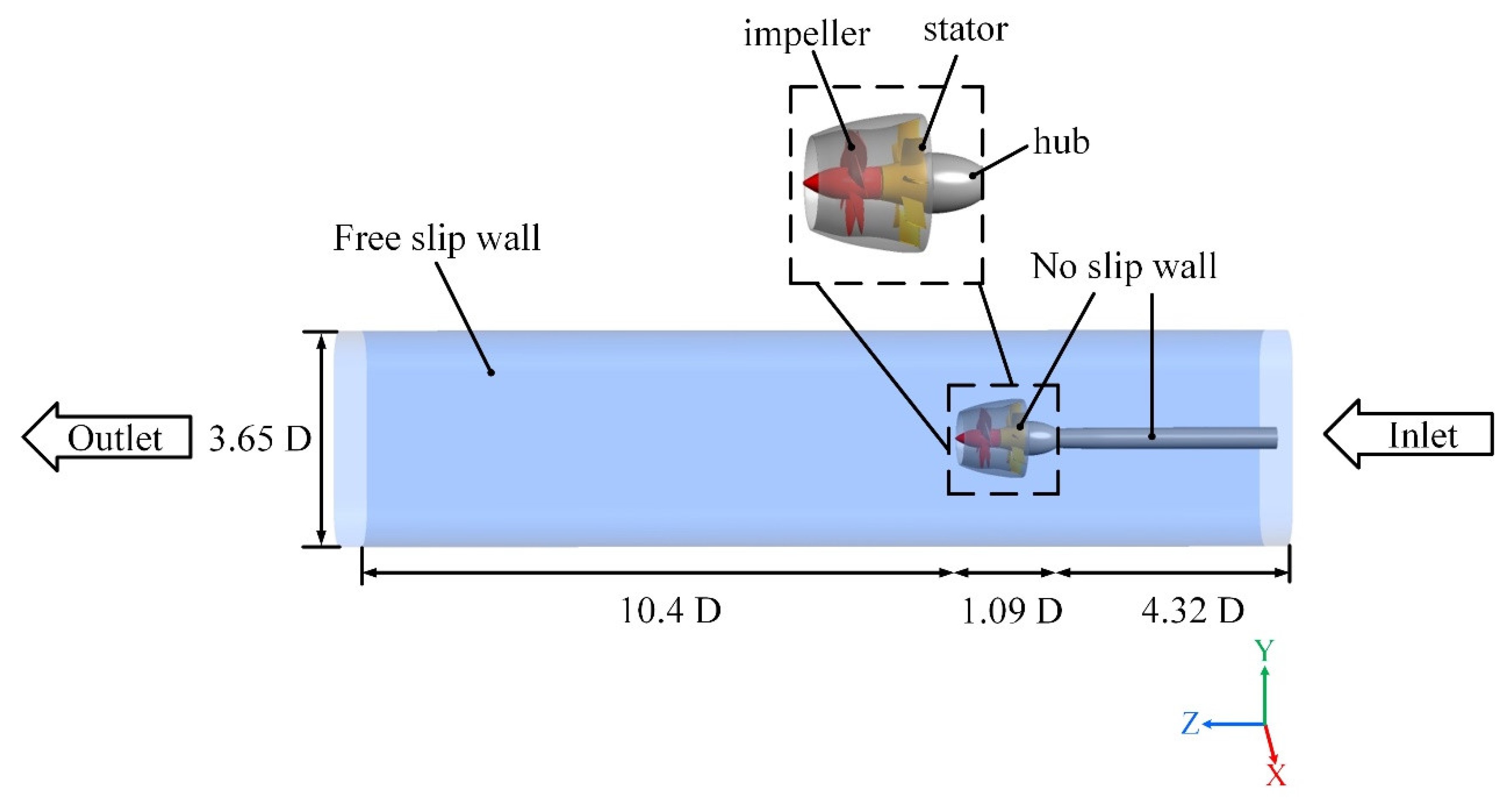
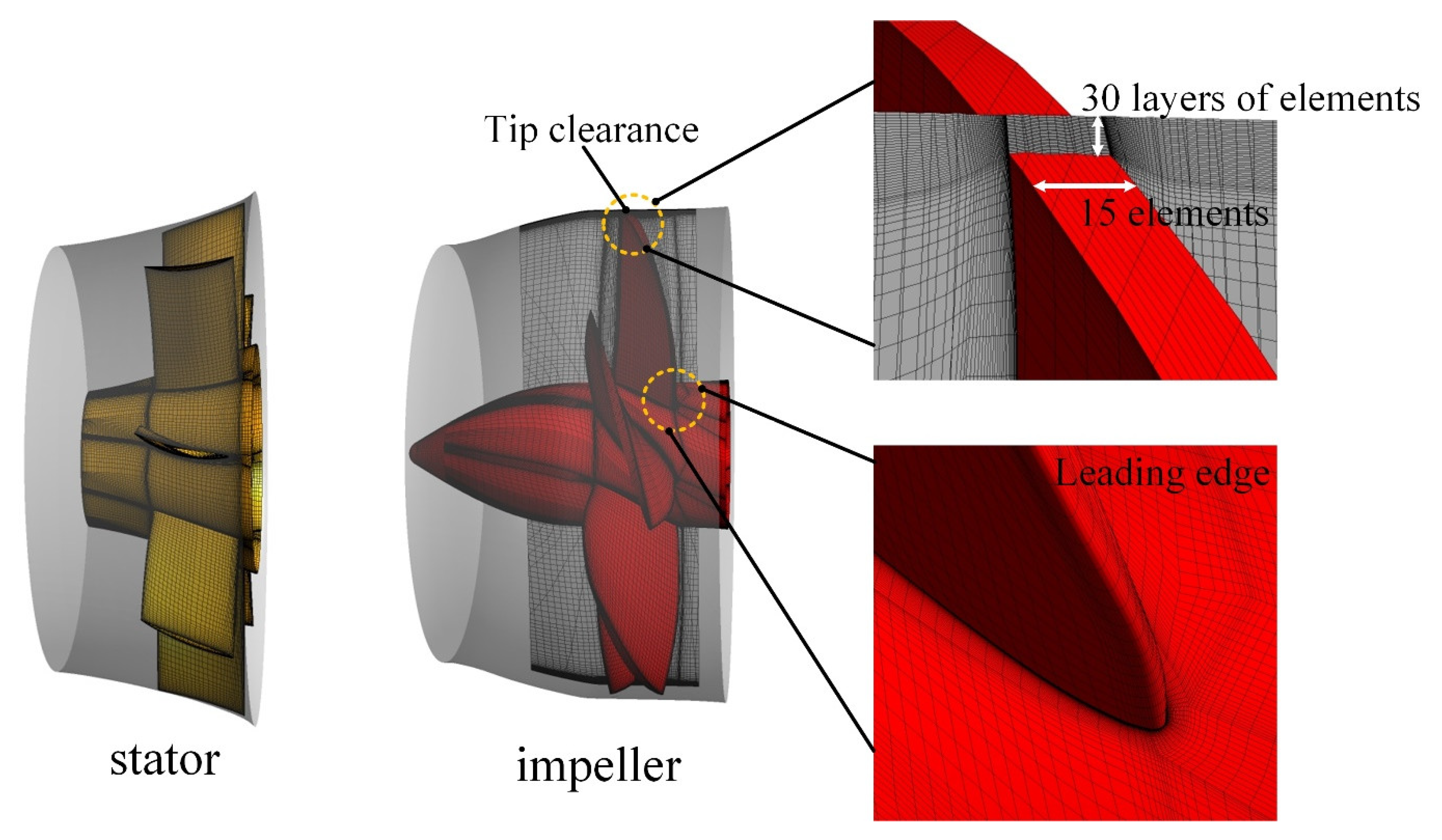
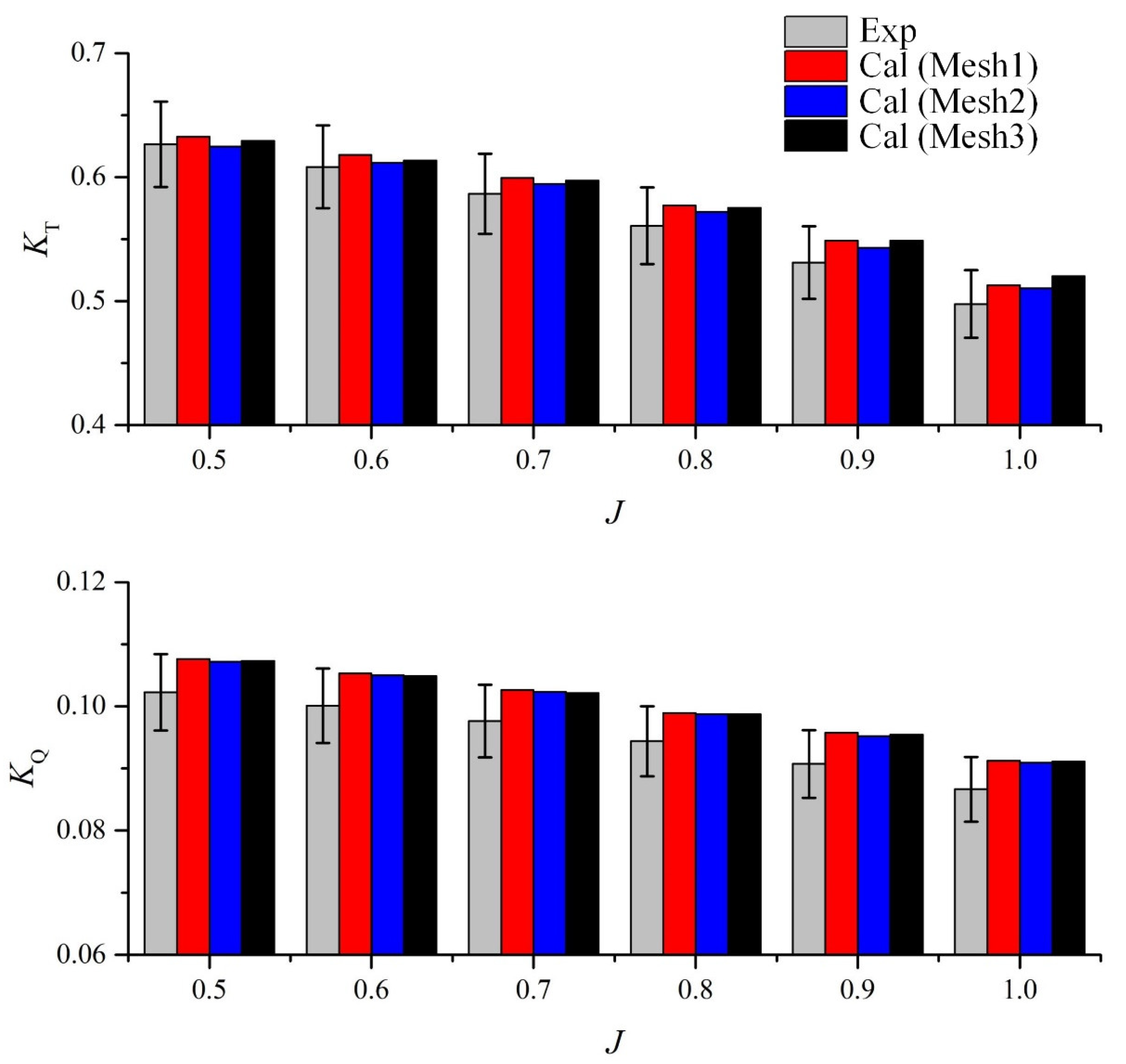

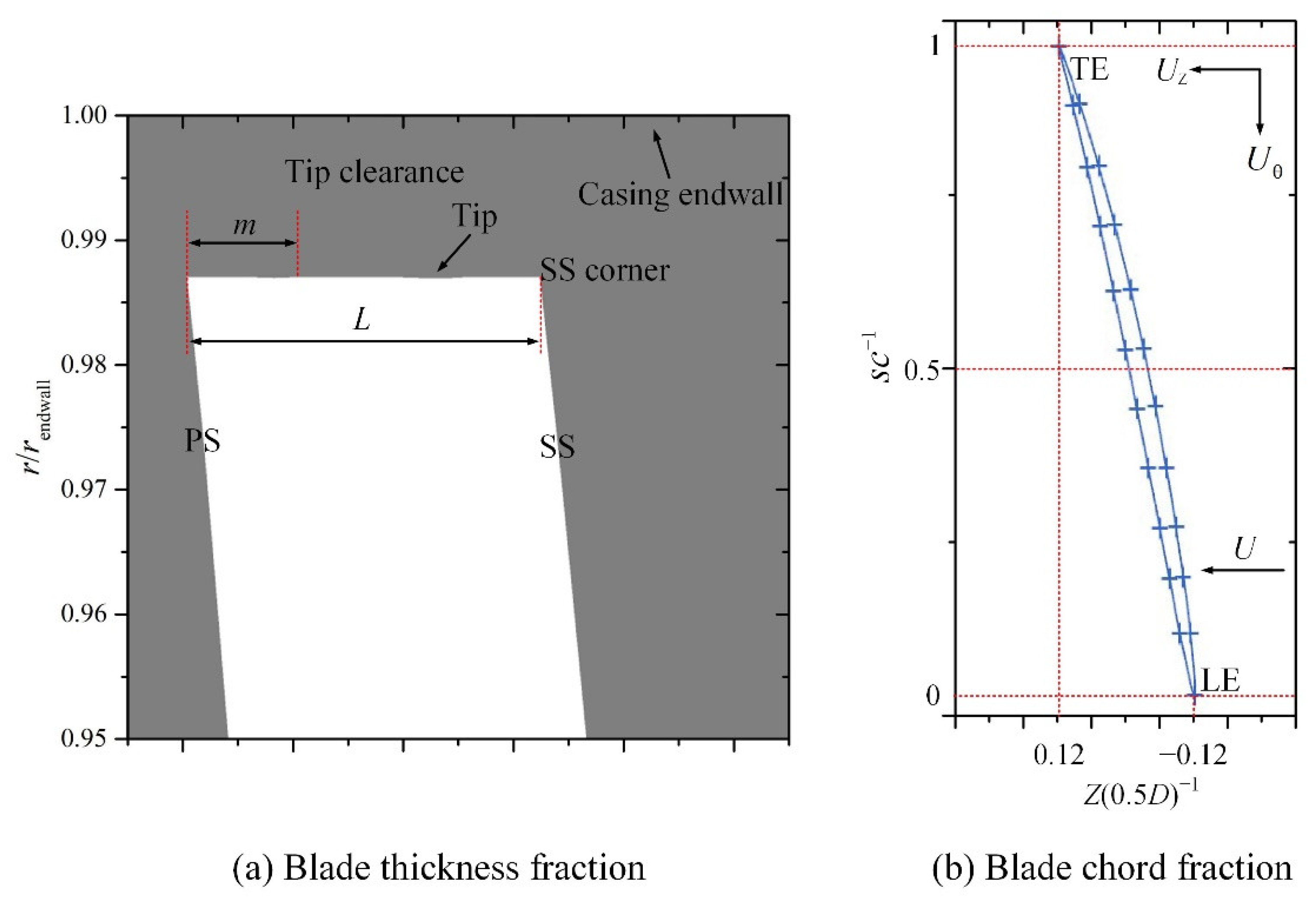

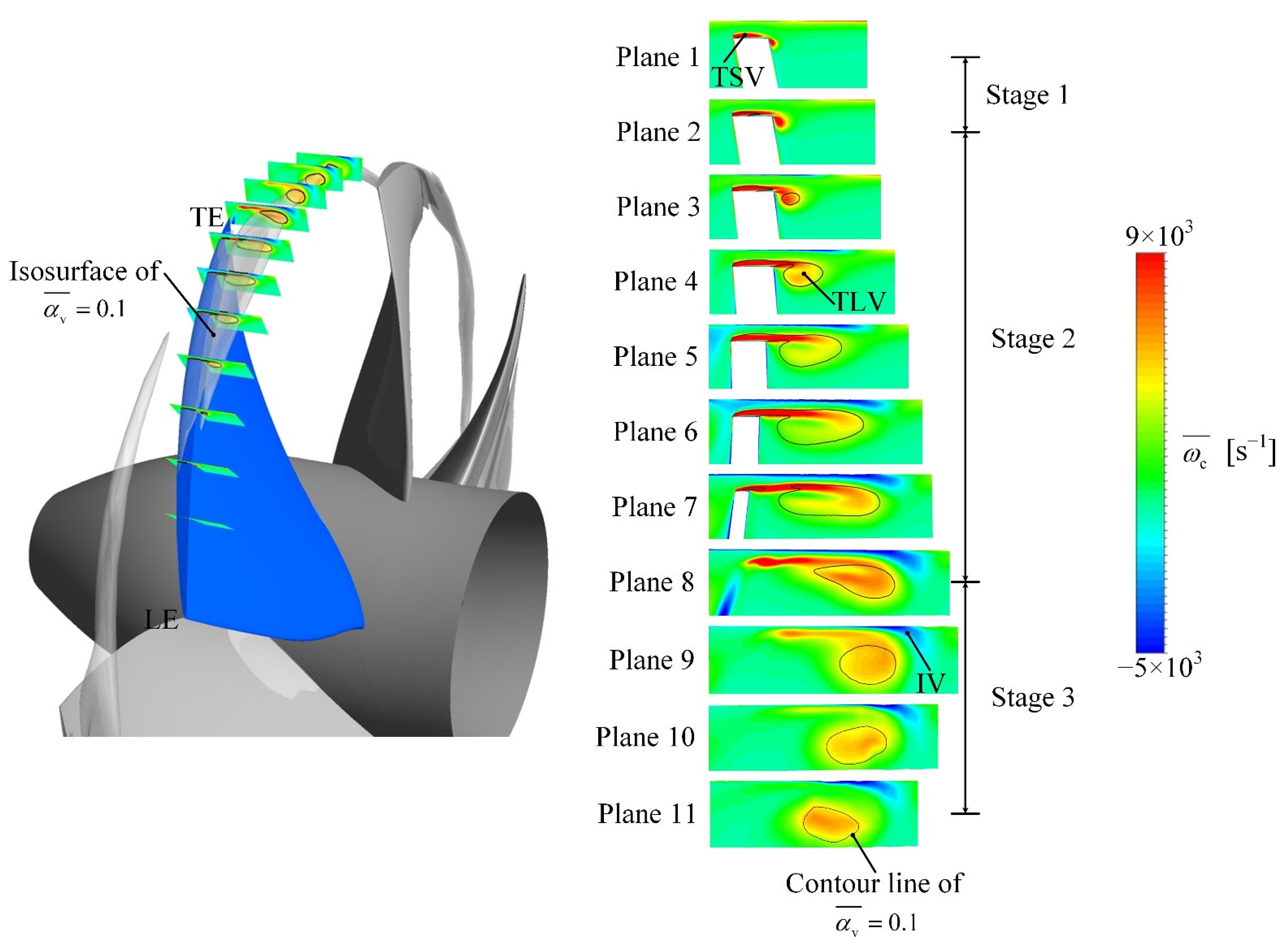
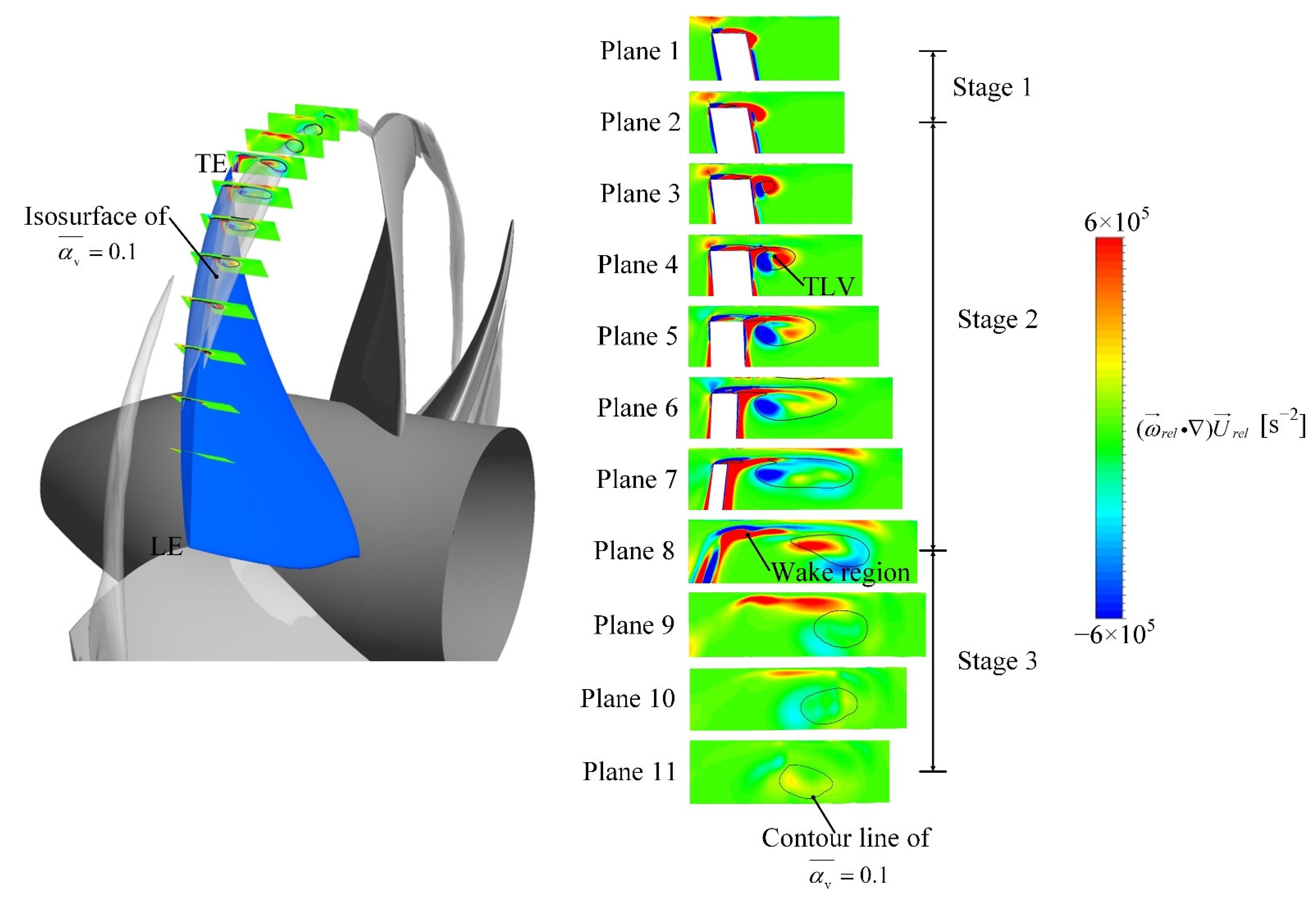
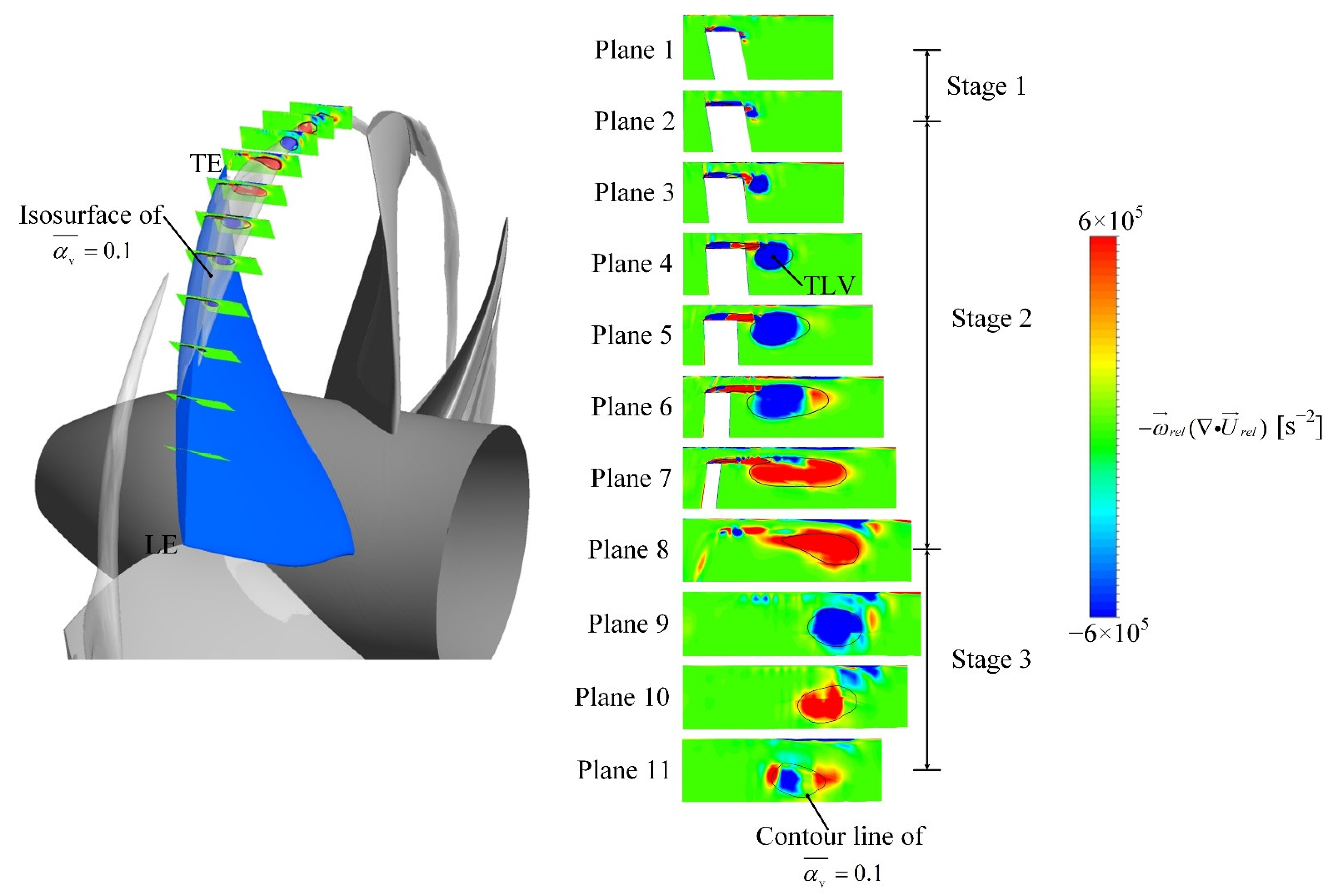
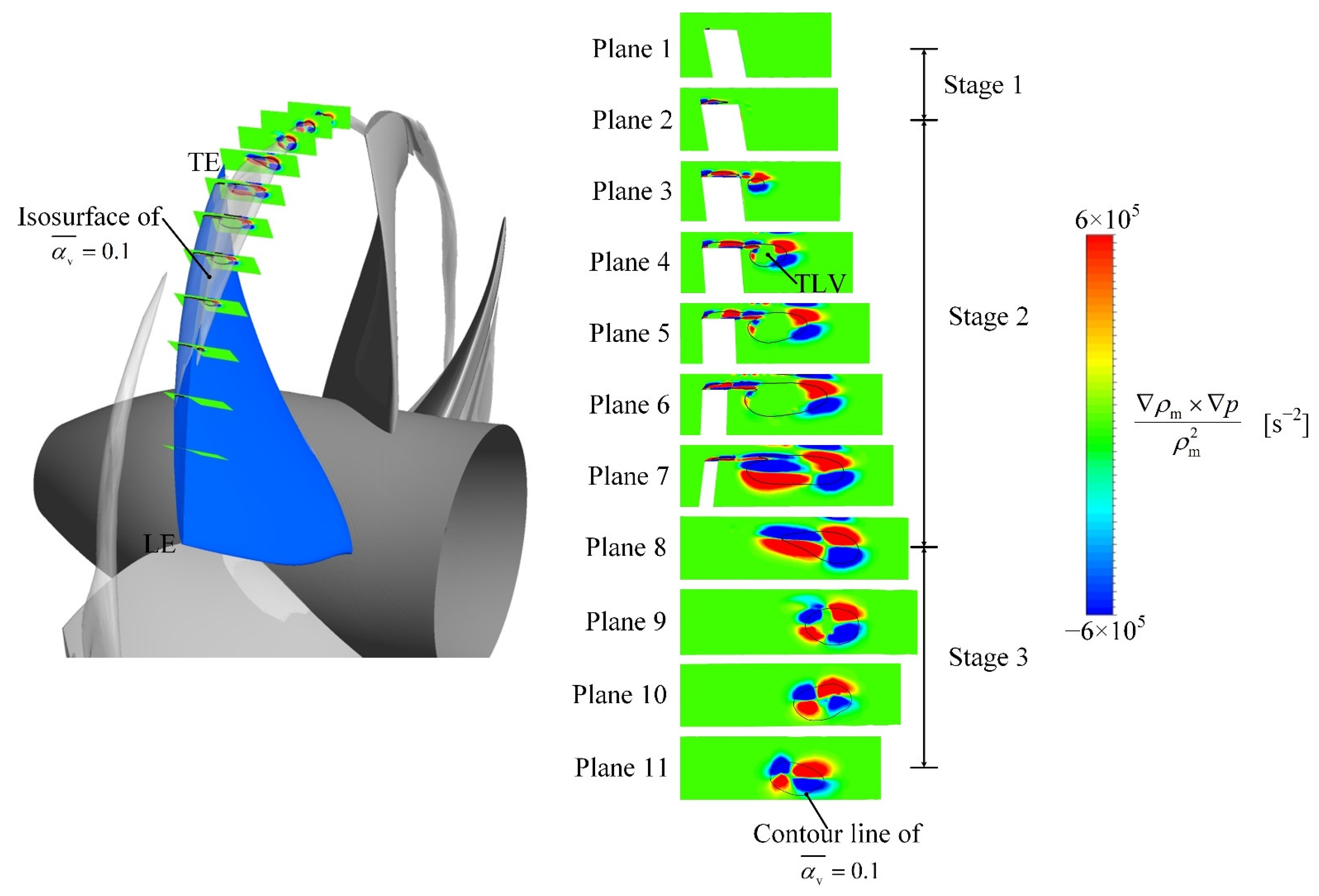
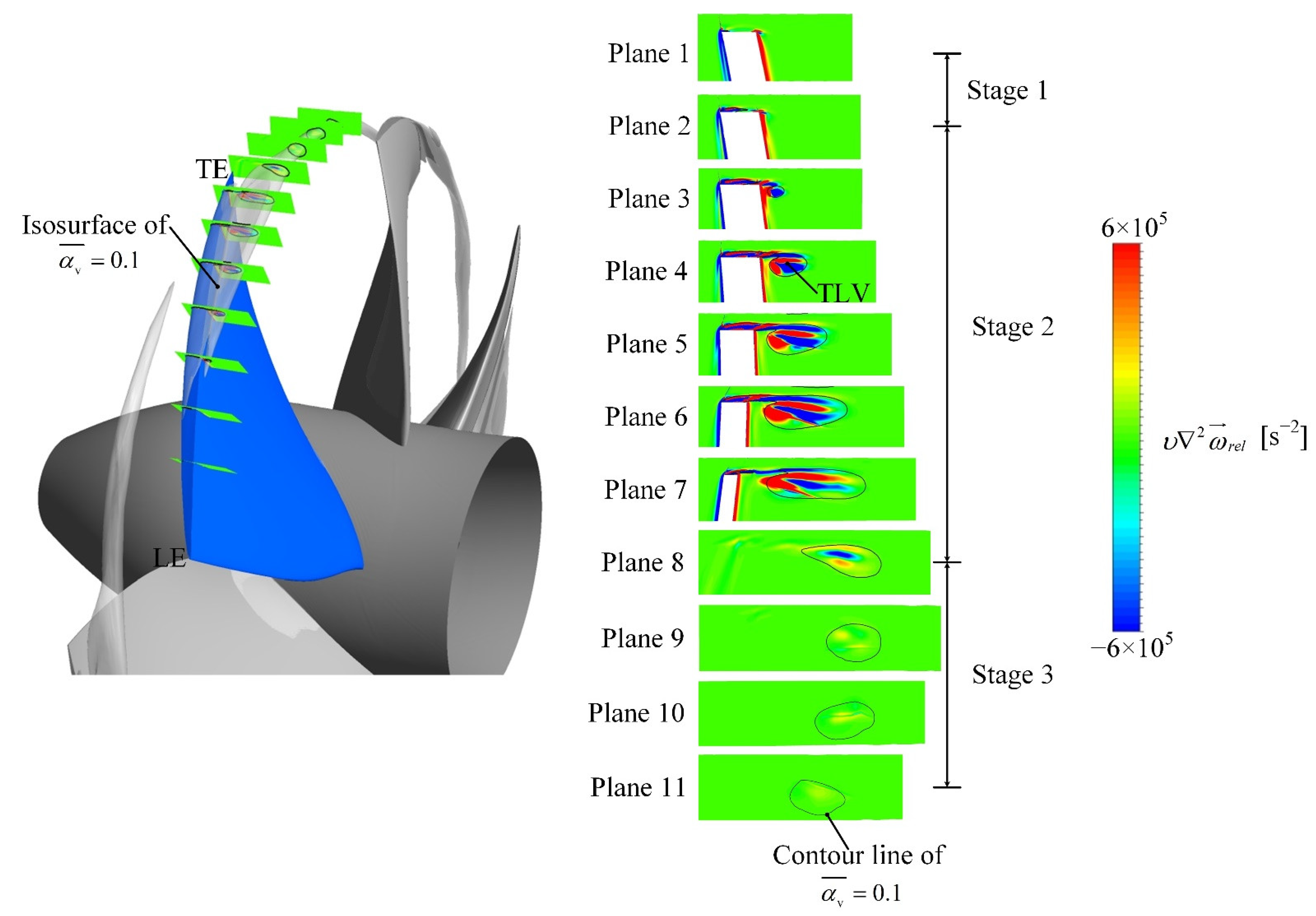
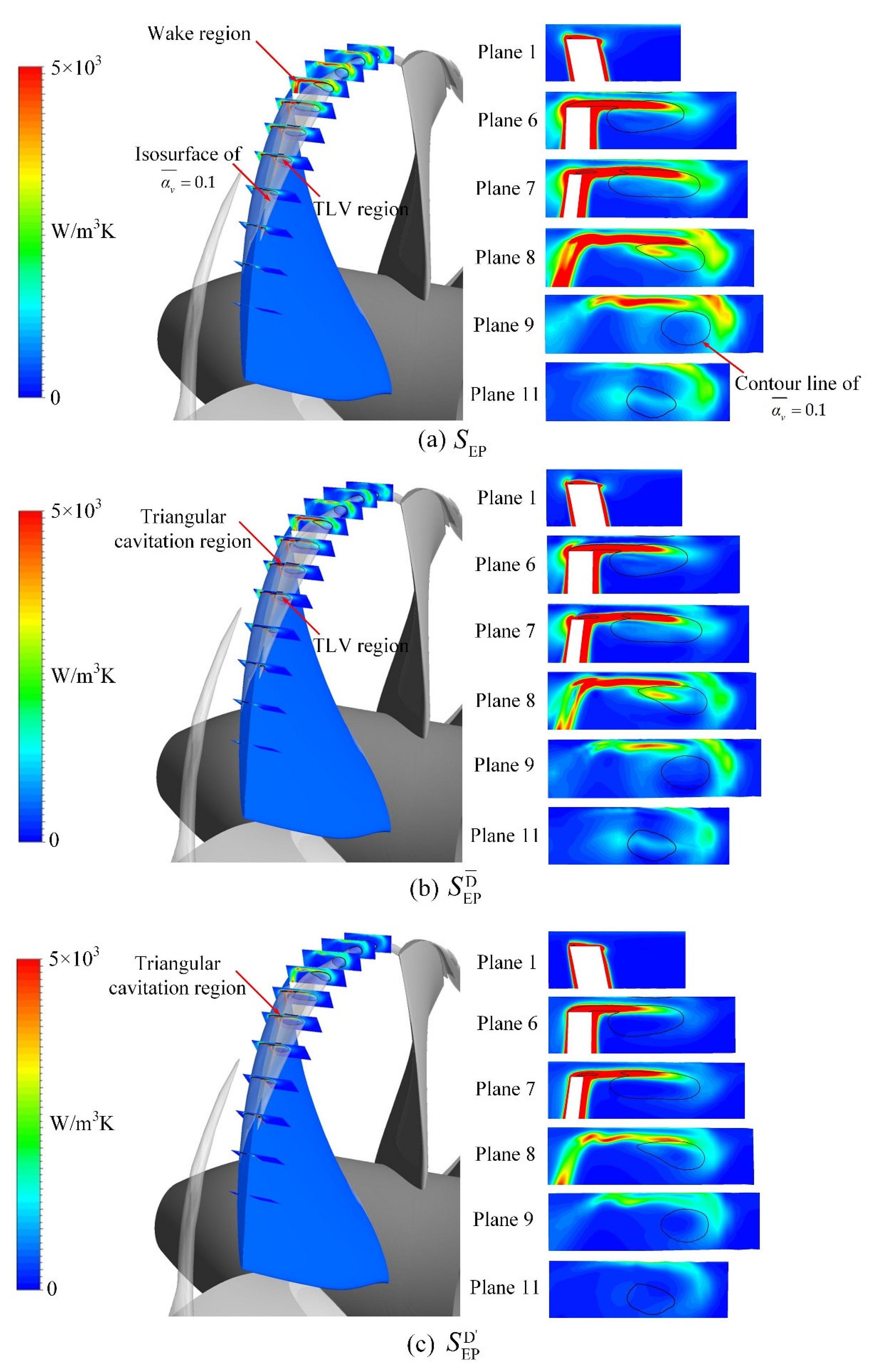
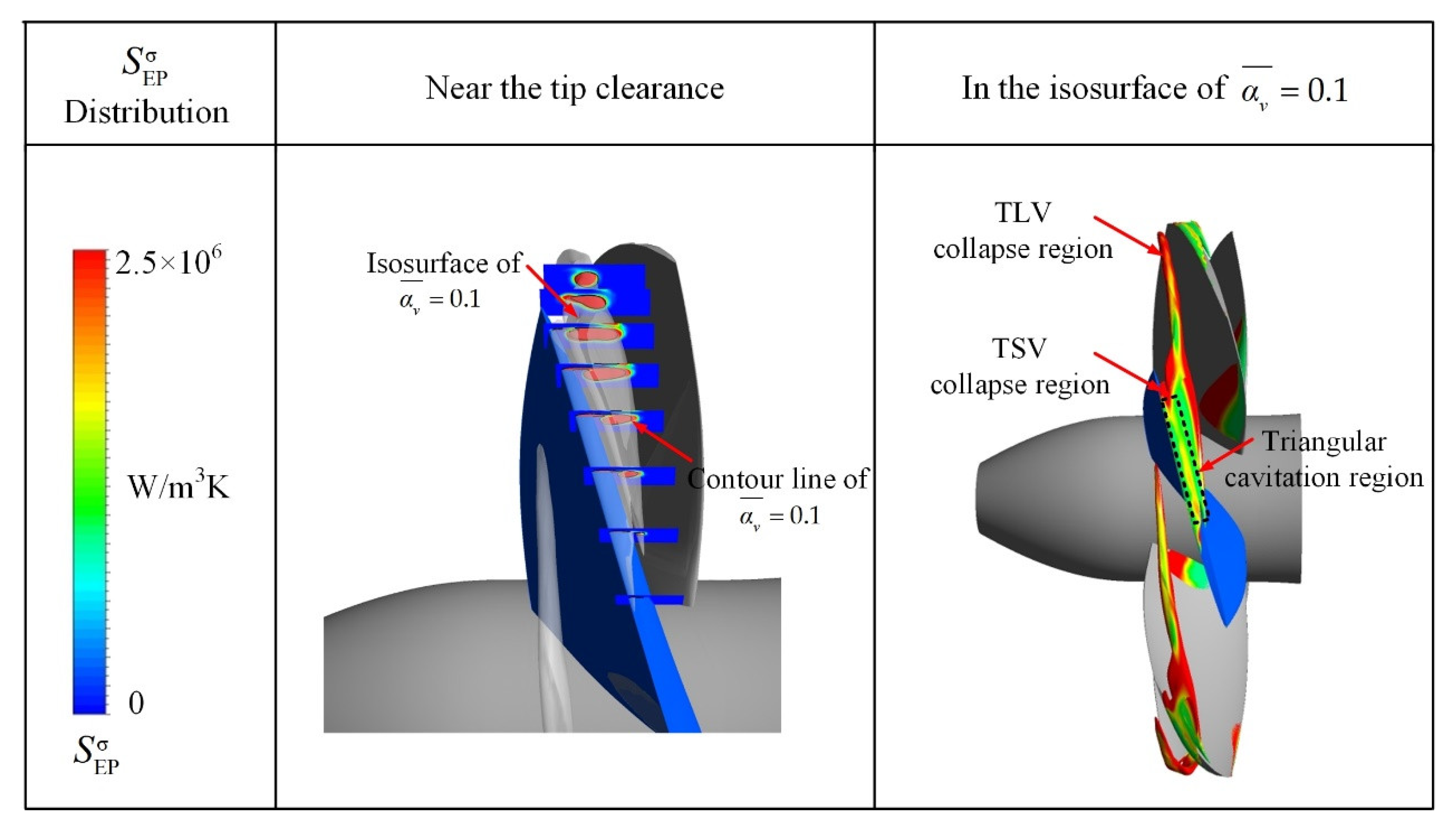
| Mesh No. | Number of Elements |
|---|---|
| Mesh 1 | 3,392,135 |
| Mesh 2 | 6,497,196 |
| Mesh 3 | 11,102,036 |
Publisher’s Note: MDPI stays neutral with regard to jurisdictional claims in published maps and institutional affiliations. |
© 2022 by the authors. Licensee MDPI, Basel, Switzerland. This article is an open access article distributed under the terms and conditions of the Creative Commons Attribution (CC BY) license (https://creativecommons.org/licenses/by/4.0/).
Share and Cite
Lv, S.; Wang, X.; Cheng, H.; Ji, B. Numerical Investigation of Tip Leakage Vortex Cavitating Flow in a Waterjet Pump with Emphasis on Flow Characteristics and Energy Features. Energies 2022, 15, 6916. https://doi.org/10.3390/en15196916
Lv S, Wang X, Cheng H, Ji B. Numerical Investigation of Tip Leakage Vortex Cavitating Flow in a Waterjet Pump with Emphasis on Flow Characteristics and Energy Features. Energies. 2022; 15(19):6916. https://doi.org/10.3390/en15196916
Chicago/Turabian StyleLv, Shujian, Xincheng Wang, Huaiyu Cheng, and Bin Ji. 2022. "Numerical Investigation of Tip Leakage Vortex Cavitating Flow in a Waterjet Pump with Emphasis on Flow Characteristics and Energy Features" Energies 15, no. 19: 6916. https://doi.org/10.3390/en15196916
APA StyleLv, S., Wang, X., Cheng, H., & Ji, B. (2022). Numerical Investigation of Tip Leakage Vortex Cavitating Flow in a Waterjet Pump with Emphasis on Flow Characteristics and Energy Features. Energies, 15(19), 6916. https://doi.org/10.3390/en15196916








